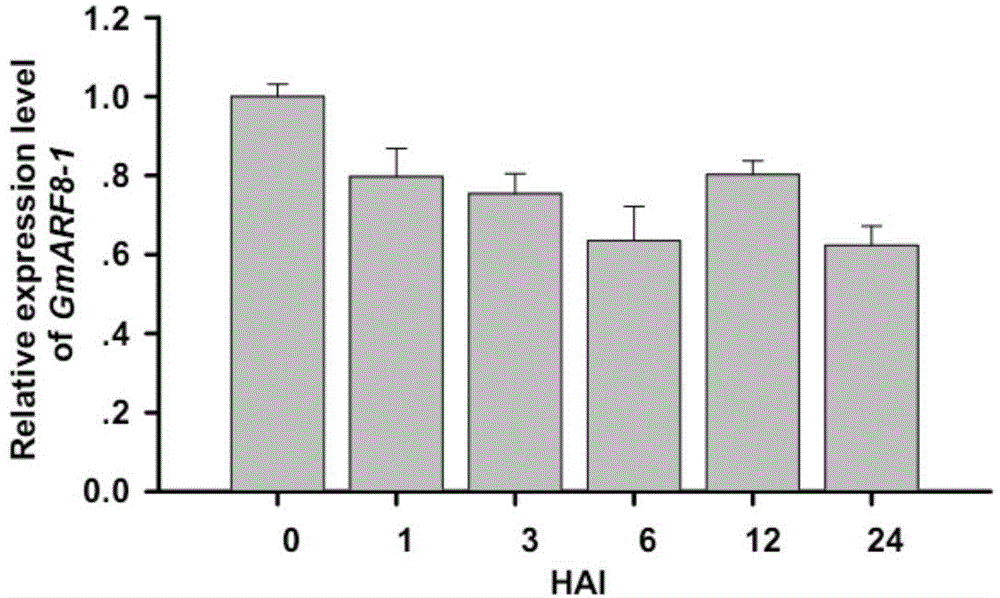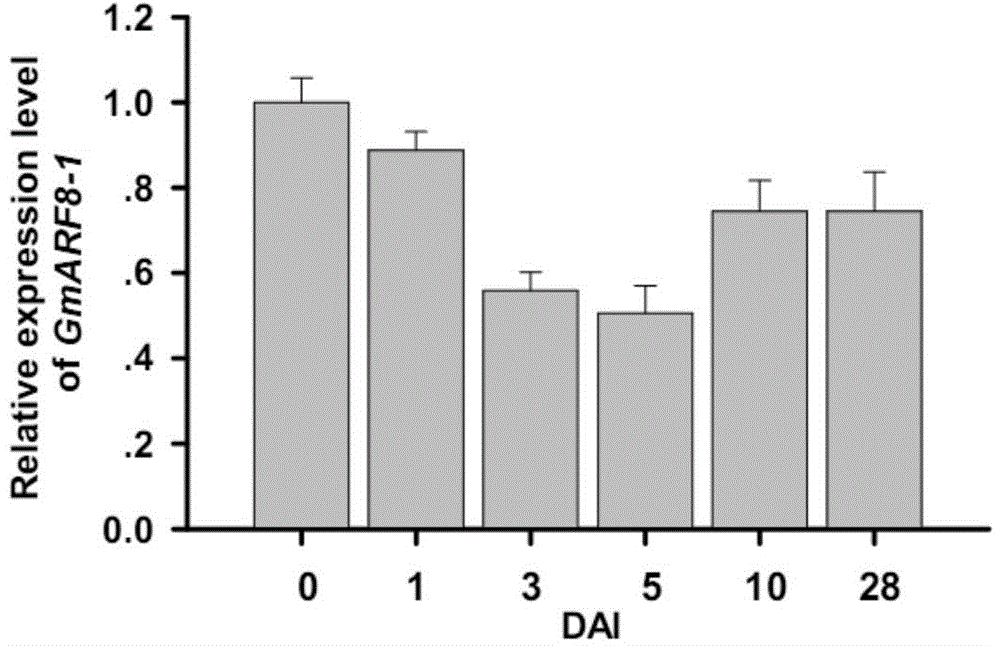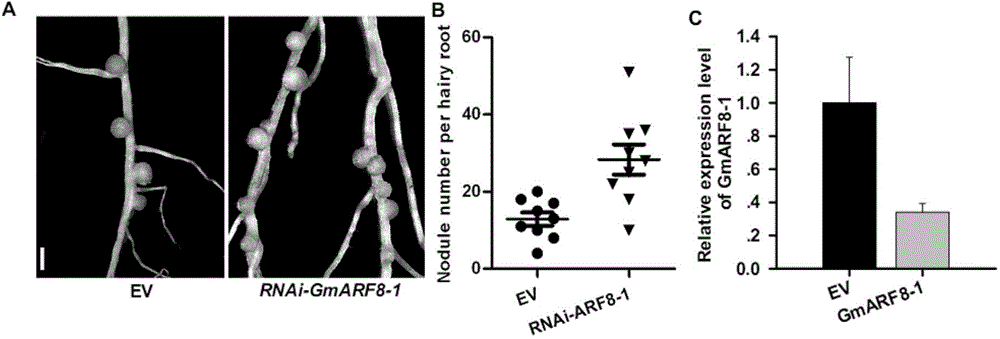RNA (ribonucleic acid) interference vector and application thereof in culture of high nodulation nitrogen-fixing plants
A technology of RNA interference and carrier, applied in the field of RNA interference carrier
- Summary
- Abstract
- Description
- Claims
- Application Information
AI Technical Summary
Problems solved by technology
Method used
Image
Examples
Embodiment 1
[0023] Example 1, Analysis of the expression pattern of GmARF8L1 gene in early response to rhizobia infection
[0024] 1) Material acquisition: The material used in the experiment was Williams 82 (W82 for short); the material was carried out according to the following process: soybean seeds were sterilized with 70% alcohol for 30 seconds, and sowed in vermiculite perlite soaked in low-nitrogen nutrient solution (3 :1) In the mixed medium, culture in the culture room, 16h light / 8h dark, light intensity 7000LUX, temperature 26°C, relative humidity 70%. Seven days after sowing, each plant was inoculated with Bradyrhizobium USDA110 bacterial solution (OD 600 : 0.08) 30ml, take soybean roots respectively at 0, 1, 3, 6, 12 and 24 hours after inoculation;
[0025] 2) Isolation of mRNA: Use the Trizol method to extract soybean total RNA. ①Put the tissue into a grinder and grind it with liquid nitrogen for 3 times, add 50-100 mg of the ground tissue into a 1.5 mL centrifuge tube, then...
Embodiment 2
[0031] Example 2, Analysis of the expression pattern of GmARF8L1 at different stages of root nodule development
[0032] 1) Material acquisition: The material used in the experiment was Williams 82 (W82 for short); the material was carried out according to the following process: soybean seeds were sterilized with 70% alcohol for 30 seconds, and sowed in vermiculite perlite soaked in low-nitrogen nutrient solution (3 :1) In the mixed medium, culture in the culture room, 16h light / 8h dark, light intensity 7000LUX, temperature 26°C, relative humidity 70%. Seven days after sowing, each plant was inoculated with Bradyrhizobium USDA110 bacterial solution (OD 600 :0.08) 30ml, the soybean root and leaf tissues were taken respectively at 0, 1, 3, 5, and 10 days after inoculation;
[0033]2) Isolation of mRNA: Use the Trizol method to extract soybean total RNA. ①Put the tissue into a grinder and grind it with liquid nitrogen for 3 times, add 50-100 mg of the ground tissue into a 1.5 mL...
Embodiment 3
[0039] Example 3. Using the RNA interference vector to down-regulate the GmARF8L1 gene to cultivate transgenic soybeans with high ability to nodulate and fix nitrogen.
[0040] 1) Extraction of total RNA from functional leaf tissue of Wilimas82 soybean
[0041] The mortar has been treated at 180°C for 8 hours or burned to eliminate RNase contamination; reagents such as chloroform, isopropanol, and ethanol should be freshly opened and uncontaminated; other equipment such as pipette tips, centrifuge tubes and reagents such as ultrapure water , NaAc, were all treated with 1‰ DEPC water overnight, then sterilized at 121°C for 30 minutes, and the pipette tip and centrifuge tube were dried at 65°C for later use; Trizol method was used to extract soybean total RNA:
[0042] (1) Take 50mg of material (leaf) and grind it with liquid nitrogen, add 1ml of redzol reagent, after fully homogenizing, inhale the homogenate into a 1.5ml centrifuge tube, and place it at room temperature for 5 m...
PUM
 Login to View More
Login to View More Abstract
Description
Claims
Application Information
 Login to View More
Login to View More - R&D
- Intellectual Property
- Life Sciences
- Materials
- Tech Scout
- Unparalleled Data Quality
- Higher Quality Content
- 60% Fewer Hallucinations
Browse by: Latest US Patents, China's latest patents, Technical Efficacy Thesaurus, Application Domain, Technology Topic, Popular Technical Reports.
© 2025 PatSnap. All rights reserved.Legal|Privacy policy|Modern Slavery Act Transparency Statement|Sitemap|About US| Contact US: help@patsnap.com



